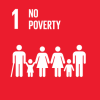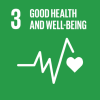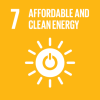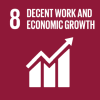European Neighbourhood Policy - South - indicators for sustainable development goals
Data extracted in March 2023.
Planned article update: April 2024.
Highlights
The children under-5 years mortality rate declined in most of the European Neighbourhood Policy-South countries during the last decade, with the strongest declines in Palestine and Morocco.
Real gross domestic product per capita showed a marked decline from 2019 to 2020 in all ENP-South countries for which data are available, a consequence of the global COVID-19 pandemic. In 2021, real GDP per capita rebounded in most of the ENP-South countries.
Among the ENP-South countries, unemployment rates for men were highest in Lebanon (2022 estimates), at 28.4 %, and for women in Palestine at 42.9 % in 2021. The lowest rates were reported in Israel, with 5.1 % for men and 4.9 % for women in 2021.
The largest unemployment gender gap among the ENP-South countries was recorded in Palestine, with 20.5 percentage points more unemployed women than men in 2021. In comparison, in the EU, the gender gap was 0.7 percentage points more unemployed women than men.
Under-5 mortality rate, 2011 and 2021
This article is part of an online publication and presents a set of indicators in relation to sustainable development; it focuses on information for nine countries that form the European Neighbourhood Policy-South (ENP-South) region — Algeria, Egypt, Israel, Jordan, Lebanon, Libya, Morocco, Palestine [1] and Tunisia; no recent data are available for Syria.
Full article
General overview
In September 2015, the United Nations (UN) adopted an agenda entitled Transforming our world: the 2030 Agenda for Sustainable Development. In order to keep track of progress for delivering this 2030 agenda in a systematic and transparent way, Eurostat, together with other services of the European Commission (EC), seeks to highlight, through the release of a wide range of official statistics for the European Union (EU), the progress made and the challenges faced with respect to the 17 Sustainable Development Goals (SDGs).
Both the UN and the EU have established detailed indicator lists for regular monitoring of the SDGs. The UN global indicator set, initially adopted in 2017 and subsequently refined in the two following years, includes 232 different indicators covering all of the 169 targets in the 2030 Agenda. The EU SDGs indicator set has been aligned — as far as appropriate — with the UN list of global indicators; however, it does not intend to cover all aspects of the SDGs or to fully reproduce the UN global list. Instead, it includes indicators relevant to the EU, which allow SDGs to be monitored in the context of long-term EU policies.
This article presents ad hoc information and is based on indicators that currently form part of Eurostat's regular data collection exercise for ENP-South countries, rather than a specific data collection exercise related to SDGs. The data can be found in Eurostat's online database.
The information provided below follows a descriptive approach, presenting a statistical picture of the situation for a number of SDGs that have been selected primarily on the basis of data availability; as such, the article covers only four of the 17 SDGs. It provides a brief description of the targets developed by the UN for each of these goals and presents specific indicators — among those selected by the UN — to measure progress being made towards achieving these goals.
SDG 1 — Ending poverty in all of its forms across the world
SDG 1 calls for 'ending poverty in all of its forms across the world'. One of the areas in which progress should be achieved concerns reducing by at least half the proportion of men, women and children of all ages who are living in poverty according to national definitions by 2030 (Target 1.2). To do so, the UN has defined Indicator 1.2.1 as the proportion of population living below the national poverty line, by sex and age.
The data presented in Figure 1 show the proportion of the population considered to be at risk of poverty or social exclusion (abbreviated AROPE), a key poverty indicator. This is the sum of people that are either at-risk-of-poverty after social transfers, severely materially deprived or living in households with very low work intensity. It should be noted that persons are counted only once, even if they are affected by more than one of these phenomena.
- The share of people at risk of poverty is calculated in relation to those living with an income that is less than 60 % of the national median equivalised income (a commonly used definition for the relative poverty line, otherwise known as a poverty threshold). Poverty rates measure the proportion of the population who are living below the poverty line. Poverty rates are a relative measure because they are calculated separately for each country; someone who is below the poverty line in one country might have been above it in another country (given the same income).
The data shown in Figure 1 is presented after redistribution of income, in other words after social transfers, for men and women.
In 2020, the most recent year for which data is available, the highest share of men at risk of poverty was recorded in Egypt, with 30.4 %, while the highest share of women at risk of poverty was recorded in Palestine with 29.7 % (2017 estimate). In Egypt, the shares of men and women at risk of poverty or social exclusion increased by 4.6 percentage points (pp) for men and 4.5 pp for women over the period 2001-2020. For Palestine, the estimated shares increased by 3.3 pp for men and 3.5 pp for women over 2011-2017.
Compared with 2011 the risk of poverty or social exclusion rate in Israel fell by -1.3 pp to 18.5 % in 2020 for men and by -2.2 pp to 18.8 % for women. In Algeria, data are available only for 2011, when 5.4 % of men and 5.5 % of women were at risk of poverty; no more recent data is available for Algeria. Morocco's estimated risk of poverty or social exclusion was 1.7 % for both men and women in 2019. It should be noted that both Algeria and Morocco applied different definitions of the risk of poverty. Data is not available for Jordan, Libya and Tunisia.
The rate of poverty or social exclusion in the EU was higher than that in Israel in 2020: 20.6 % of men were at risk of poverty or social exclusion, while 22.4 % of women were at risk. However, these rates were lower than in 2011, by -2.8 pp for men, and by -3.2 pp for women.

(%)
Source: Eurostat (ilc_peps01) and (enps_ilc_natln)
SDG 3 – Ensure healthy lives and promote well-being
SDG 3 seeks to 'ensure healthy lives and promote well-being'. Within this context, Target 3.2 is focused on child mortality, including ending preventable deaths of newborns and children under 5 years of age by 2030, with all countries aiming to reduce neonatal mortality to at least as low as 12 per 1 000 live births and under-5 mortality to at least as low as 25 per 1 000 live births. It should be noted that this indicator is not included on the EU list of SDG indicators, but is calculated specifically for this article. Traditionally, official statistics have measured the infant mortality rate based on the number of newly born children dying before their first birthday. Figure 2 presents the under-5 mortality rate.
All ENP-South countries where data are available reported a decline in infant mortality rate in the period under review, with the exceptions of Egypt and Libya. All these countries, except Israel, had under-5 mortality rates higher than in the EU in both 2011 and 2021 (or the years for which the most recent data is available). In Israel, the rate declined over the period by -0.9 per 1 000 live births; from 4.4 to 3.5 per 1 000 live births.
Morocco had the highest under-5 mortality rate among the ENP-South countries in both 2011 and 2018 (the most recent data available for the country), when it was 22.2 per 1 000 live births. However, Morocco had the second largest decline among the ENP-South countries during this period, at -8.3 per 1 000 live births. In Algeria, there were 21.3 under-5 deaths per 1 000 live births in 2020; this rate had declined by -5.5 per 1 000 live births from 2011. Egypt's rate increased by 0.7 per 1 000 live births from 2011 to 19.8 per 1 000 live births in 2020. In Jordan in 2021, there were 19.0 under-5 deaths per 1 000 live births, which was a decrease of -1.0 per 1 000 live births from 2009. Palestine reported a fall in under-5 mortality rates of -9.2 per 1 000 live births from 2009 to 14.2 per 1 000 live births in 2020, representing the largest decrease in the ENP-South region. Libya recorded an increase of 4.0 per 1 000 live births from 2010 to 2020, when the rate was 11.5. It is not possible to assess the development of this rate in Lebanon as data is only available for one year: in 2009 it recorded an estimated 10.0 per 1 000 live births. No data is available for Tunisia.
In the EU, under-5 mortality rates were 3.8 per 1 000 live births in 2021, a decline of 0.8 per 1 000 live births from 2011.
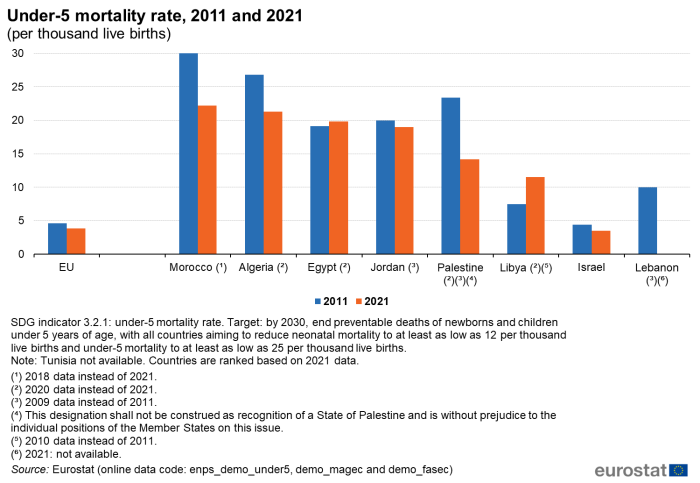
(per thousand live births)
Source: Eurostat (demo_magec), (demo_fasec) and (enps_demo_under5)
SDG 7 – Ensure access to affordable, reliable, sustainable and modern energy for all
SDG 7 seeks to 'ensure access to affordable, reliable, sustainable and modern energy for all'. One area of progress that should be achieved concerns doubling the global rate of improvement in energy efficiency by 2030 (Target 7.3). In order to measure progress in this domain, the UN has agreed upon the use of Indicator 7.3.1 as a measure of energy intensity. Energy intensity is used as a proxy for energy efficiency: it can be affected by a number of factors, such as climate or the structure of an economy. This indicator is defined as the gross inland consumption of energy in relation to constant price (or volume) GDP, in other words, the energy supplied to the economy per unit of economic output; if the ratio declines over time this indicates that less energy is required, thereby confirming that the economy concerned has made progress in relation to energy efficiency gains.
Figure 3 shows that overall, in the two ENP-South economies for which data are currently available, energy intensity has fallen over time, suggesting that their economies were more energy efficient by the end of the time series available than at the beginning. A long time series is only available for Palestine, while a shorter series is available for Israel.
However, for Palestine the energy intensity fluctuated considerably over the period. In 2011, the energy intensity indicator for Palestine stood at 180 kilogram of oil equivalent per thousand euro at 2015 prices, falling to 153 kg in 2012, before rising to a peak at 184 kg in 2014. The lowest energy intensity was reported in 2018, at 136 kg. In 2020, the most recent data available, Palestine's energy intensity was 162 kg of oil equivalent per thousand euro at 2015 prices in 2020. Over the period 2011-2020 as a whole, Palestine recorded an annual average decline of -1.2 %. The short time series for Israel contains a more consistently decreasing trend of energy intensity: its energy intensity declined by an annual average of -7.4 %, from 74 kg of oil equivalent per thousand euro in 2018 down to 59 kg in 201, decreasing each year during this period. In each of these years, Israel's energy intensity was below that recorded in the EU. The EU's energy intensity fell gradually from 2011 to 2021 by an annual average of -1.7 %, reaching 117 kilogrammes of oil equivalent per thousand euro in 2021. The amount of energy required to produce a unit of GDP remained 39 % higher in Palestine than in the EU in 2020.
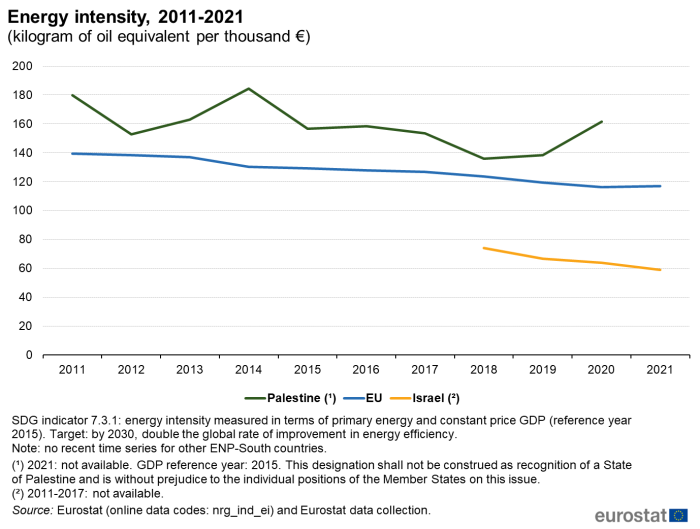
(kilogram of oil equivalent per thousand €)
Source: Eurostat (nrg_ind_ei) and Eurostat data collection.
SDG 8 – Promote sustained, inclusive and sustainable economic growth, full and productive employment and decent work for all
SDG 8 aims to 'promote sustained, inclusive and sustainable economic growth, full and productive employment and decent work for all'. As part of this, one target is to sustain economic growth per inhabitant in accordance with national circumstances and, in particular, at least 7 % growth per annum in the least developed countries (Target 8.1).
To measure progress towards this target, the UN has agreed upon Indicator 8.1.1. This indicator is retained in the EU list of SDG indicators and is defined as the annual growth rate of real GDP per capita; it is often used as a proxy for living standards or to measure the health of an economy. An analysis of GDP per capita (per person) removes the influence of the absolute size of the population, making comparisons between different countries easier. GDP per capita is therefore a broad economic indicator that may be used for a basic analysis of average living standards. It is measured using 'real' or constant price GDP to remove the effects of changes in prices. Nevertheless, differences in national accounts compilation methods may affect comparisons among ENP-South economies. The information shown in Figure 4 provides annual percentage changes in constant price, or 'real' GDP per capita.
GDP per capita showed a marked decline in all reporting countries in 2020 as a consequence of the Covid-19 pandemic, followed by a rebound in 2021 in all available countries except Jordan.
Looking at changes in 'real' per capita GDP over the time period for which data is available, as measured in constant 2015 prices, the most rapid growth was recorded in Israel, where GDP per capita in constant prices increased over 2011-2021 by an annual average of 2.0 %. In Morocco, GDP per capita increased by an annual average 1.3 % over 2015-2021. Per capita change in GDP in constant prices was slightly positive in Palestine over 2011-2022 at an average 0.3 % per year and in Egypt at 0.4 % over 2012-2017. Average annual per capita change in GDP in constant prices was slightly negative in both Algeria (-0.1 % per year over 2011-2021) and Tunisia (-0.5 % per year over 2011-2020). Jordan's GDP per capita declined at an annual average rate of -2.5 % over 2011-2021. In Libya over 2011-2019, despite large annual fluctuations in real GDP per capita, caused by civil war as well as fluctuations in petroleum prices, ranging from an estimated -47.6 % in 2011 to an estimated +80.8 % in 2012, there was no change in the average real GDP per capita (±0.0 %).
The annual average per capita growth in GDP in the EU, measured in 2015 constant prices, was 1.3 % over 2011-2022. The effects of the global financial and economic crisis of 2008-2009 and the subsequent sovereign debt crisis were still felt in several EU Member States for several years thereafter. Growth picked up again at EU level during the period 2014-2019, notably with growth of 2.7 % in 2017. The 2020 negative growth rate, at -5.7 %, was heavily affected by the Covid-19 pandemic; in 2021, real GDP per capita rebounded with an increase of 5.5 %.
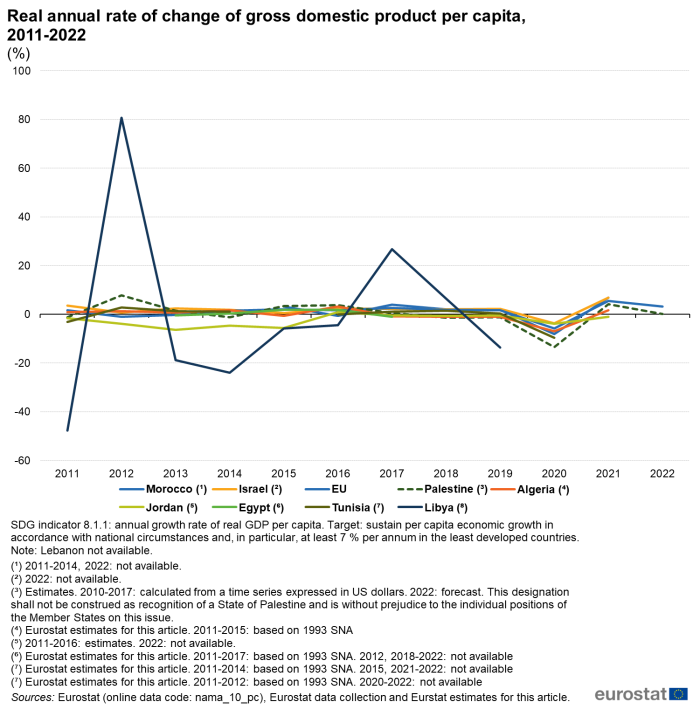
(%)
Source: Eurostat (nama_10_pc), (enps_nama_10_gdp) and Eurostat estimates for this article.
SDG Target 8.5 concerns 'achieving full and productive employment and decent work for all women and men, including for young people and persons with disabilities, and equal pay for work of equal value by 2030'. The UN has agreed to monitor unemployment rates by sex and age and for persons with disabilities (Indicator 8.5.2). Unemployment data for men and women is shown in Figure 5 for 2011 and 2021 (or the latest available data) as a percentage of the economically active population aged 15-74 years, those either employed or unemployed.
Among the ENP-South countries, unemployment rates varied broadly. The highest recent unemployment rate for men is the 2021 estimate for Lebanon at 28.4 %; 32.7 % of women in the country were also unemployed. For women, the highest unemployment rate in 2021 was found in Palestine with 42.9 %; for men, unemployment affected 22.4 %. Palestine also recorded the highest increase among the ENP-South countries over 2011-2021 in both male unemployment, by 3.3 pp, and in female unemployment, by 14.5 pp.
High unemployment rates were also recorded in Tunisia in 2021, at 15.4 % for men and 23.6 % for women (2011 data not available). Morocco reported unemployment rates at 11.0 % for men and 16.9 % for women in 2021. There was an increase in unemployment rates in Morocco over 2011-2021 for men of 2.5 pp and for women of 6.6 pp. In Algeria in 2019, 9.1 % of men and 20.4 % of women were unemployed. These numbers represented an increase from 2011 of 0.7 pp for men and 3.2 pp for women.
In Egypt, the unemployment rate for men decreased over 2011-2021 by -3.3 pp to 5.6 %, while the rate for women declined by -6.7 pp to 16.0 %. However, a change in definition should be noted; while the 2011 data covered unemployment among those aged 15-74 years, in 2021 only ages 15-64 years were covered. Data for Libya in 2021 are not available, but in 2010 the unemployment rates were 13.2 % for men and 14.2 % for women.
In 2021, the lowest unemployment rates among the ENP-South countries were reported in Israel for both men and women: the unemployment rate for men was 5.1 %, while the corresponding rate for women was 4.9 %. Data for Israel in 2011 are not available. No data were available for Jordan.
EU unemployment rates were lower than for most ENP-South countries, especially for women, the exception being Israel. EU unemployment rates stood at 6.7 % for men and at 7.4 % for women in 2021. These rates represented a decline in unemployed men from 2011 of -3.0 pp and -2.7 pp for women.
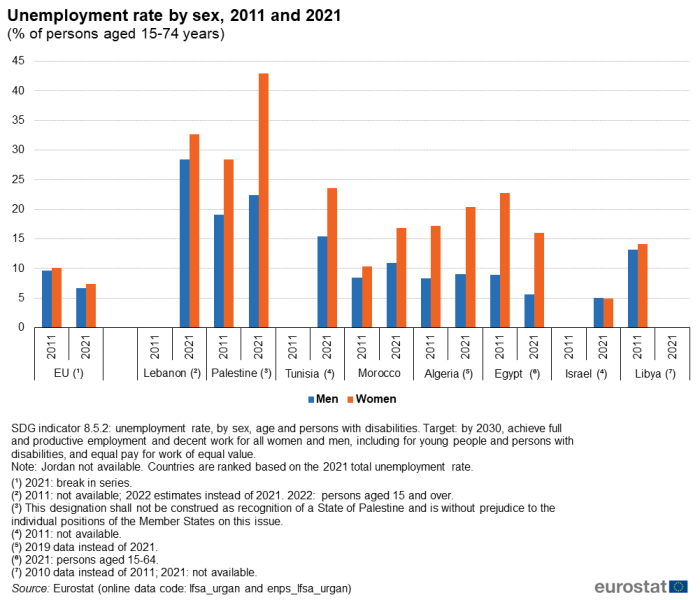
(% of persons aged 15-74 years)
Source: Eurostat (lfsa_urgan) and (enps_lfsa_urgan)
In both 2011 and 2021, most ENP-South countries recorded lower unemployment rates for men than for women. The largest unemployment gender gap in 2021 was recorded in Palestine, with a 20.5 pp difference between men and women. The gap had increased by 11.2 pp since 2011. Between 2011 and 2019, Algeria recorded an increase of 2.5 pp to a gender gap of 11.3 pp.
Egypt's unemployment rates reflected a high gender gap. However, this decreased over 2011-2021 by -3.4 pp to 10.4 pp. In this context, the change in definition in Egypt with respect to the age group covered should be considered. In Tunisia, only data for 2021 are available, showing an unemployment gender gap of 8.2 pp. In Morocco, the 2021 gender gap was 5.9 pp, an increase of 4.1 pp from 2011. Lebanese data is only available for 2022, when the gender gap was estimated at 4.3 pp. Libya reported a 0.9 pp gender gap in 2010 (2020 data not available). In Israel there was a negative unemployment gender gap in 2021, with 0.2 pp more men than women unemployed.
In the EU, unemployment rates are relatively equally distributed between genders. In 2021, there were 0.7 pp more women unemployed than men, a marginal increase in the gender gap of 0.3 pp from 2011.
Indicator 8.5.2 also covers an analysis of unemployment rates by age: policymakers tend to focus their attention on both ends of working life, analysing employment opportunities for the young and the retention of older members of the workforce up to and beyond the official retirement age (if one exists). Figure 6 shows unemployed young people aged 15-24 years as a percentage of all those in that age range who were economically active, either employed or unemployed.
The highest youth unemployment rates in 2021 for women were found in Palestine, where 64.5 % of young women were unemployed, close to two out of three young women. The corresponding unemployment rate for young men was 37.2 %. Since 2011, the unemployment rate of young women had increased by 10.5 pp, while the rate for young men grew by 4.9 pp. As a result, the youth unemployment gender gap increased by 5.6 pp to 27.3 pp, marginally the highest in the ENP-South countries.
In Algeria and Morocco, youth unemployment rates for both men and women increased over the period. In Algeria, the most recent figures (2019 data) were 23.6 % for young men and 45.1 % for young women. Since 2011, these numbers had increased by 4.5 pp for men and 6.9 pp for women, thus widening the gender gap by 2.4 pp to 21.5 p. Morocco reported a slightly lower rate of unemployed young women in 2011 as compared with young men, with a negative gender gap of -0.7 pp. However, the unemployment rate for women increased much faster, by 24.5 pp, than that of men, for whom the increase was 10.3 pp. As a result, in 2021 the unemployment rate was 41.9 % for young women and 28.4 % for young men. This resulted in a gender gap increase over the period of 14.2 pp to 13.5 pp in 2021.
In Tunisia, the youth unemployment rate in 2021 for men was 42.2 %, which was higher than that for women, 40.0 %, meaning a negative gender gap of -2.2 pp. These rates followed an increase of 1.4 pp in male youth unemployment from 2011 and a decrease of -5.5 pp in female youth unemployment. The gender gap thus decreased by -6.9 pp. Egypt reported youth unemployment was 24.5 % for men and 21.4 % for women in 2021. Hence, there was a negative unemployment gender gap of -3.1 pp. Since 2011, male youth unemployment had increased by 9.9 pp, while female youth unemployment declined by -0.9 pp. The gender gap had thus shrunk by -10.8 pp.
In Lebanon in 2022, estimated youth unemployment rate was 46.1 % for men and 52.3 % for women, a gender gap of 6.2 pp; 2011 data for comparison is not available. In Jordan and in Libya, data for 2021 are not available for the youth unemployment rate. In Libya in 2012, the youth unemployment rates were 40.8 % for men and 67.8 % for women, a gender gap of 27.0 pp. In Jordan, youth unemployment in 2011 was 36.3 % for men and 35.1 % for women, a negative gender gap of -1.2 pp.
In Israel, the youth unemployment rate for both genders declined over the period, to 7.5 % for men and 8.0 % for women in 2021, so that there was a 0.4 pp gender gap (note that the figures are rounded). The rates had declined by -4.3 pp for men and -3.4 % for women over the decade, marginally increasing the gender gap by 0.9 pp.
In comparison, in the EU, both youth unemployment rates declined, although the gender gap marginally increased by 0.6 pp. For young men, the unemployment rate stood at 16.5 % in 2021, lower by -5.5 pp than it had been in 2011. For young women, the rate was 16.7 % in 2021, -4.9 pp lower than in 2011. As a result, in 2021, the gender gap was 0.2 pp.
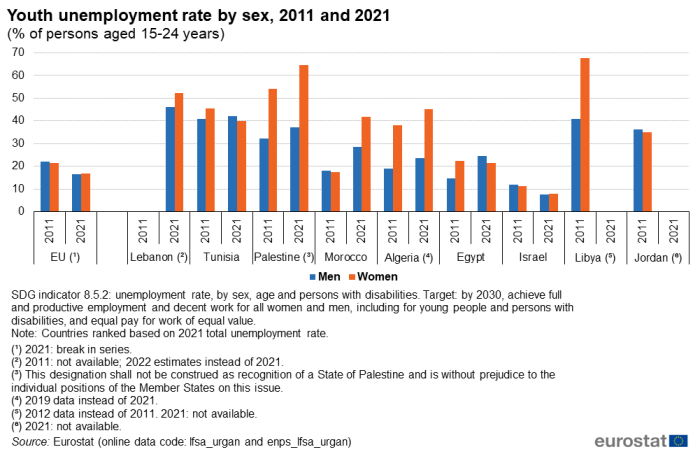
(% of persons aged 15-24 years)
Source: Eurostat (lfsa_urgan) and (enps_lfsa_urgan)
Source data for tables and graphs
Data sources
The data for ENP-South countries are supplied by and under the responsibility of the national statistical authorities of each country on a voluntary basis. The data that are presented in this article result from an annual data collection cycle that has been established by Eurostat. No recent data are available for Syria.
The statistics are available free-of-charge on Eurostat's website, together with a range of additional indicators covering most socio-economic topics.
Context
Sustainable development is a global concern that is linked to a wide range of economic, social and environmental challenges present within the world. However, sustainable development also provides opportunities, such as the potential to eliminate extreme poverty or measures that are designed to stimulate a sustainable path to economic growth.
In September 2015, an important milestone was reached, as the UN adopted a new agenda titled Transforming our world: the 2030 Agenda for Sustainable Development.
UN indicators for measuring sustainable development
The UN's 2030 Agenda for sustainable development is a long-term policy designed to bring about a systemic change in the way that economic growth, social cohesion and environmental protection go hand in hand. It addresses both poverty eradication and the economic, social and environmental dimensions of sustainable development, underpinned by good governance.
The agenda covers a set of 17 Sustainable Development Goals (SDGs) — each designed to address a range of global challenges:
- no poverty;
- zero hunger;
- good health and well-being;
- quality education;
- gender equality;
- clean water and sanitation;
- affordable and clean energy;
- decent work and economic growth;
- industry, innovation and infrastructure;
- reduced inequalities;
- sustainable cities and communities;
- responsible consumption and production;
- climate action;
- life below water;
- life on land;
- peace, justice and strong institutions;
- partnerships for the goals.
In March 2016, the United Nations Statistical Commission (UNSC) agreed on a global list of 241 SDG indicators as a practical starting point to monitor the 17 SDGs and 169 targets at a global level (of these, nine indicators are repeated for different targets). The SDG indicators framework is refined annually.
The monitoring of SDGs is based on different levels of analyses (referred to by the UN as ‘tiers’). Only indicators in the first of these three tiers have an agreed concept, an established methodology and the regular release of data; the other two tiers suffer either from a lack of regular data collection (Tier 2 indicators) or from the lack of established concepts, definitions, methodologies or standards (Tier 3 indicators). Indeed, the UN continues to work on defining the scope and coverage of Tier 3 indicators. A Resolution was adopted by the General Assembly in 2017 committing to revising the UN indicator list over time. After refinements in March 2021, the current list is composed of 247 indicators (12 of which are repeated for different targets, meaning there are 231 unique indicators in total). At the time of writing, data are not available for all of these indicators. The global indicator list will, as well, be complemented by indicators at the regional and national levels, which will be developed by member states.
For more information on work being conducted in this area and the approach adopted by UN for the development of SDG indicators, please refer to UN's SDG indicators website. The UN releases quarterly updates of its global database for SDG indicators; it is available online.
Sustainable development — what role for the European Union?
Sustainable development is a fundamental and overarching objective of the EU. Indeed, it is enshrined in Article 3 of the Treaty on European Union. The EU has committed to implementing the UN 2030 agenda for sustainable development, both in its internal and external policies. In November 2016, the European Commission made a proposal for a new European consensus on development — our world, our dignity, our future (COM(2016) 740 final) which highlighted the possibilities available for developing a new framework for achieving sustainable development and poverty eradication. This proposal states that the 2030 agenda should be used to guide EU actions with neighbouring countries, including those covered by the revised European Neighbourhood Policy (ENP). Furthermore, the Communication also proposes that the EU should seek to boost the statistical capacity of developing countries, including: strengthened capacity for the production and analysis of data (disaggregated where possible by income, gender, age and other factors); information on marginalised, vulnerable and hard-to-reach groups; inclusive governance; investment in stronger statistical institutions at national and regional level; the promotion and use of new technologies and data sources.
In November 2016, the European Commission also adopted a Communication entitled Next steps for a sustainable European future — European action for sustainability (COM(2016) 739 final), identifying that the EU's global strategy on foreign and security policy had clear links with the UN 2030 agenda for sustainable development, whereby links and benefits for the EU could be achieved by promoting security and prosperity in surrounding regions, including enlargement and ENP countries. Furthermore, the Communication foresees the development of an SDG indicator framework, whereby the European Commission will 'seek to carry out more detailed regular monitoring of the SDGs in an EU context' which should draw on work already being carried out by the European Commission and its agencies, as well as the European External Action Service.
These policies are, in 2022, under review through the European Semester process.
As the statistical office of the EU, Eurostat may consider that there are a number of UN indicators which lie outside the scope of official statistics, for example, indicators on governance. Furthermore, in developed economies, some of the indicators from the UN indicator list for monitoring SDGs may be considered as being of little or no relevance, as they refer to issues that are more pertinent for analysing developing countries. Examples include indicators measuring the share of the population that is living within close proximity of a paved road or the availability of modern methods for family planning.
With this in mind, and following the Communication on European action for sustainability, European Commission services have developed an EU-specific indicator list, designed to measure progress in relation to sustainable development issues. The EU's monitoring framework for SDGs is based largely on data that is already available for the EU Member States (the 'acquis'); this divergence in approach to that adopted by the UN reflects the considerable differences in economic, social and environmental developments across the different continents, regions and countries of the world and the degree of relevance for some UN indicators with respect to measuring progress on sustainable development issues in the EU.
For more information on work already conducted in this area and the approach adopted by Eurostat, please refer to Eurostat's website.
European Neighbourhood Policy
The European Neighbourhood Policy (ENP), launched in 2003 and developed throughout 2004, supports and fosters stability, security and prosperity in the EU's neighbourhood. The ENP was revised in 2015. The main principles of the revised policy are a tailored approach to partner countries; flexibility; joint ownership; greater involvement of EU Member States and shared responsibility. The ENP aims to deepen engagement with civil society and social partners. It offers partner countries greater access to the EU's market and regulatory framework, standards and internal agencies and programmes.
The Joint Communication on Renewed Partnership with the Southern Neighbourhood – A new Agenda for the Mediterranean, accompanied by an Economic and Investment Plan for the Southern neighbours, of 9 February 2021 further guides cooperation with the ENP-South countries.
The main objective of Euro-Mediterranean cooperation in statistics is to enable the production and dissemination of reliable and comparable data, in line with European and international norms and standards.
Reliable and comparable data are essential for evidence-based decision-making. They are needed to monitor the implementation of the agreements between the EU and the ENP-South countries, the impact of policy interventions and the reaching of the Sustainable Development Goals (SDGs).
The EU has been supporting statistical capacity building in the region for a number of years through bilateral and regional capacity-building activities. This takes the form of technical assistance to partner countries' national statistical authorities through targeted assistance programmes, such as the MEDSTAT programme and activities such as training courses, working groups and workshops, exchange of best practice and the transfer of statistical know-how. Additional information on the policy context of the ENP is provided here.
Notes
- ↑ This designation shall not be construed as recognition of a State of Palestine and is without prejudice to the individual positions of the Member States on this issue.
Direct access to
Books
- Statistics on European Neighbourhood Policy countries: South — 2020 edition
- Sustainable development in the European Union — Monitoring report on progress towards the SDGs in an EU context — 2019 edition
- Sustainable development in the European Union — Overview of progress towards the SDGs in an EU context — 2019 edition
Factsheets
- Statistics for a green future — factsheets on European Neighbourhood policy-South Countries — 2022 edition
- Basic figures on the European Neighbourhood Policy-South countries — 2022 edition
- Basic figures on the European Neighbourhood Policy-South countries — 2021 edition
Leaflets
- Basic figures on the European Neighbourhood Policy — South countries — 2020 edition
- Basic figures on the European Neighbourhood Policy — South countries — 2019 edition
- Basic figures on the European Neighbourhood Policy — South countries — 2018 edition
- Basic figures on the European Neighbourhood Policy — South countries — 2016 edition
- Basic figures on the European Neighbourhood Policy — South countries — 2015 edition
- Sustainable development in the European Union — Overview of progress towards the SDGs in an EU context — 2018 edition
- Energy and transport statistics for the European neighbourhood policy-South countries — 2018 edition
- Labour force statistics for the Mediterranean region — 2016 edition
- Southern European Neighbourhood Policy countries (ENP-South) (ESMS metadata file — enps)
- European Commission — International cooperation and development — The 2030 agenda for sustainable development
- European Commission — Communication — Next steps for a sustainable European future: European action for sustainability COM(2016) 739 final
- European Commission and the High Representative for the Union for Foreign Affairs and Security Policy — Joint Communication — Review of the European Neighbourhood Policy JOIN(2015) 50 final
- European External Action Service — Middle East and North Africa (MENA)
- European External Action Service — European Neighbourhood Policy
- MEDSTAT
- United Nations — The Sustainable Development Goals Report 2019
- United Nations — Sustainable Development Goals Indicators — Global database
- United Nations — Sustainable Development Goals Indicators — Metadata repository
- United Nations — Sustainable Development Goals Indicators — Official list of indicators

